
Savarna
Savarna of New Zealand
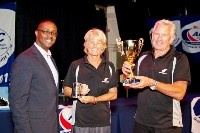
Who: Keith & Pam Goodall
Port: Auckland, New Zealand
18 July 2016
01 July 2016
30 May 2016
13 November 2015
27 October 2015
25 October 2015
22 October 2015
20 October 2015
17 October 2015
13 October 2015
10 October 2015
20 July 2015
23 May 2015
09 May 2015
09 May 2015
07 May 2015
07 May 2015
04 May 2015
30 April 2015
28 April 2015
Aruba to Santa Marta, Colombia
28 January 2015
Saturday 24th saw us go through the convoluted exit process to depart Aruba - it is not possible to hurry the process or check out in advance - and we were keen to get away as our planned possible stop on the rock we have named Alcatraz was a 54 mile passage directly downwind. Ultimately we departed, with the Customs official waiting in his car to ensure we did depart, at around 0945 hours notwithstanding we had started the process at 0800 hrs.
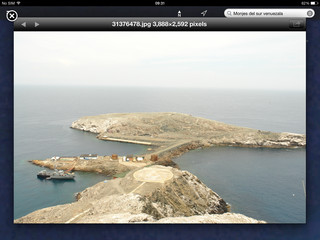
Monjes Del Sur from lighthouse(courtesy google earth)
We had heard of a Venezuelan Navy outpost at the head of the Gulf of Venezuela that could provide an overnight anchorage and thus mean we would only have one night at sea on the passage to Santa Marta in Colombia. This potential overnight stop was on the island of Monjes Del Sur which is basically two barren rocks - joined by a rubble wall where the Venezuelan's have bulldozed the top off one rock to create the rubble wall, built an outpost there (no Navy boats in sight) and where young Naval officers spend one month on and one month off. Heavens know what they do there.
We had a good downwind sail to the island although during the last hour it really started to blow hard and as we rounded the corner into the "bay" (I think you could call it that) we saw two fishing boats tied up to a 50 mm rope that was stretched across the bay in front of the rubble wall. We nosed up to the rope, watched by the fisherman, and attempted to catch the rope with the boat hook but is was far too heavy. Plan B was to go stern up to the rope and drop John off in the dinghy and then fall away and come back up bow first and Pam would drop a rope to John so he could loop it around the line and pass back to Pam on the bow. That all happened reasonably ok but by this time the wind was howling across the top of the rubble wall at 35 knots plus and our line started slipping along the rope. Given this 'bay" will only hold at best 5 boats we were heading for the rocks to starboard. John managed to prevent the rope slipping further and then 3 Venezuelan fisherman dived in from their boat and took a second line further along to port and then with the two lines from the bow at different angles we were held secure. In the meantime the sailors were watching our antics from the window of their building. We had read they would want to inspect our documents and come aboard for a beer - with the wind as it was they clearly opted to stay inside and remain dry which suited us.
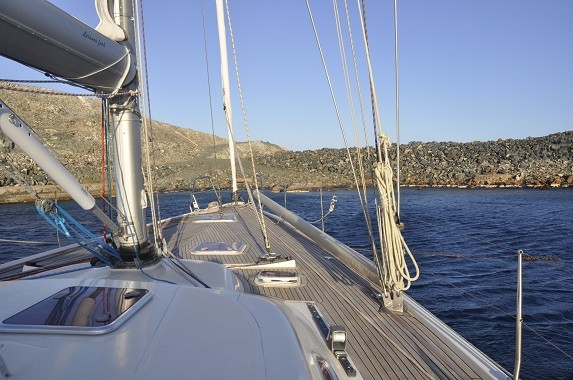
Across the bow to the rubble wall
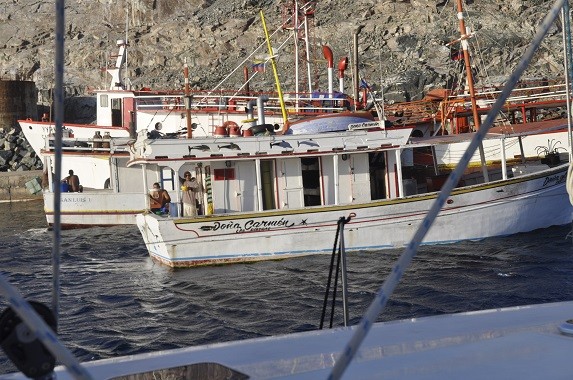
Fishing boats next to us at Monjes Del Sur
The next step in this process was to "pay" the 3 fisherman - the negotiation process (they had no English and we have no Spanish- started with an offer of 6 beers, that was rejected as they are allowed no alcohol on board their fishing boat, so next it was our last 4 cans of coke that was accepted and then we moved to the money request. So basically we ended up with a 'marina' fee for the night of USD60 which seemed a good outcome as we listened to the wind howling across the 'bay" all night.
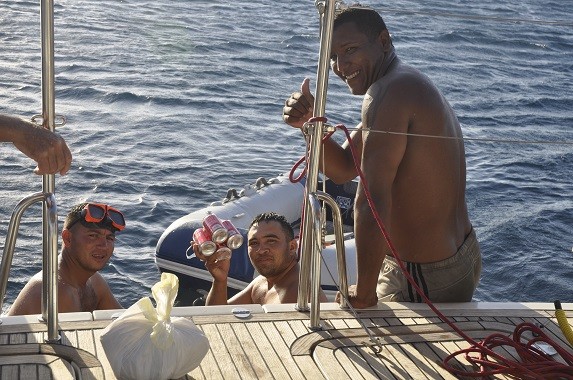
The three fisherman in midst of negotiations
The wind did ease back early morning so we headed out at the leisurely hour of 0800 for the final 240 miles to Santa Marta. Basically an uneventful passage, running directly downwind yet again, under a single reefed main only. We had planned to stay beyond the 1000 metre depth line to try and avoid the worst of the anticipated big seas but as time went on the wind eventually died so we gybed and stayed well inshore and had to motor for around 90 miles until the last few hours when the wind gradually built to 30 knots and we blasted past the lighthouse and into the shelter of Santa Marta bay and then into the marina. Beautiful clear night, half-moon until around 2300 hrs but quite cool - sweater for the first time for several weeks. Caught a lovely tuna which turned itself into sashimi and tuna steaks. Got a beautiful sized mahimahi right to the stern and half way to the deck when a last desperate twist see him get off the lure - the classic one that got away.
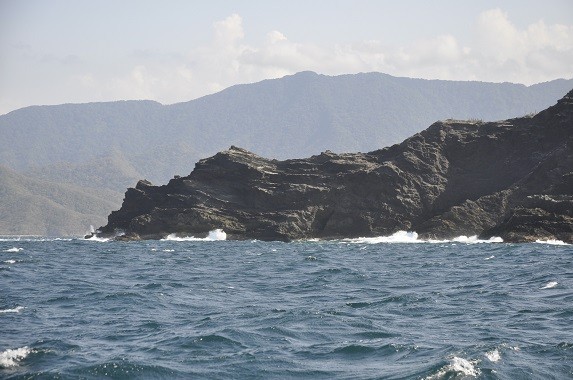
Approaching Santa Marta - rough coast
Santa Marta is a blast (population 400,000) - traffic everywhere, no traffic lights so imagine numerous four way intersections and everyone vying for right of way, no pedestrian crossings, streets full of stalls - mobile phones, shoes, and clothing dominate. The currency is fun - peso's is the name and 1,000 peso's is NZ66 cents, so it is great walking around with hundreds of thousands in your pocket. Beer is cheap at NZD1.10 a 375mil bottle!
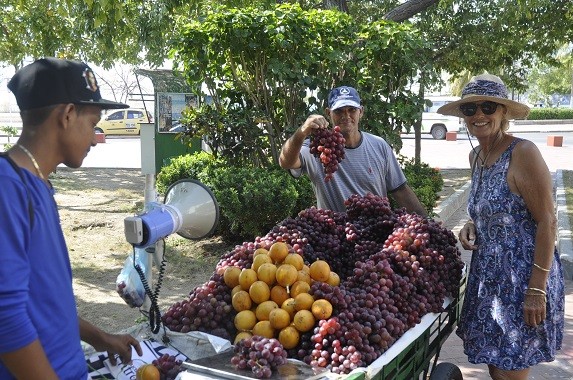
Pam buying grapes from streetside vendor
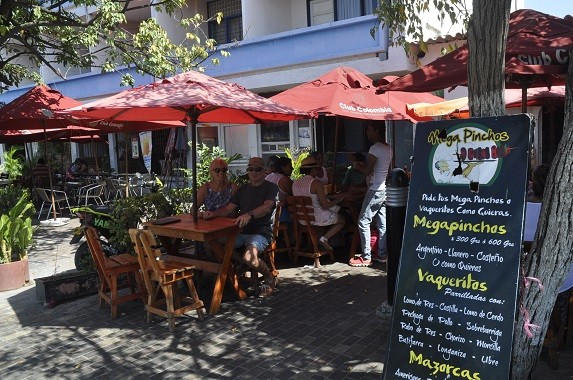
Lunch on the waterfront
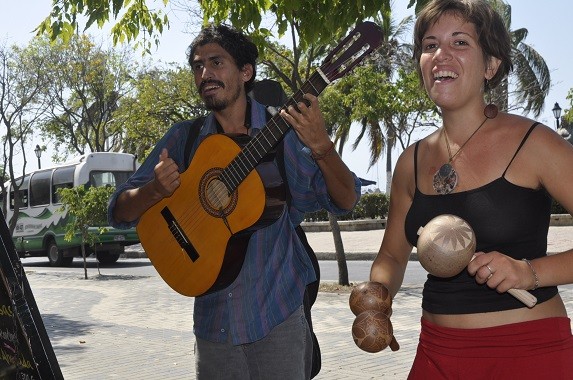
Seranaded over lunch on waterfront
To clear in with Customs and Immigration requires the use of an agent. The process takes at least two days to clear in and the same to clear out and it is necessary to go through this process in every port so taking the boat to Cartagena as well as Santa Marta would take a minimum of 8 days at quite a cost also. It seems part of the issue is around the requirement to temporarily import the boat and that involves photographs and a physical inspection. The process must have been evolved a few hundred years ago by the Spanish and has not yet been modernised as not many visiting yachts come through. There are only 6 or 7 other visiting yachts in the marina. The marina itself is very smart - keypads working off fingerprint for access so IGY have really modernised the operational part of what is a new marina facility.

Streets are packed all day long!
Santa Marta is the second oldest city in South America and was founded in 1525 by a Spanish Conquistador and sits under the snow covered Sierra Nevada mountain range with the highest peak at 18,700 feet. Unfortunately the peaks are generally shrouded in mist and as we closed in on the Colombian coast at dawn we thought we might have had a good chance of a clear view - but not to be. We will be staying here for a few days (at least 4 to clear in and out) and will probably bus to Cartagena and spend a couple of days there before then sailing the 250 miles to the San Blass islands. The main economic drivers are tourism, coffee and cocoa.
To follow our live position tracking go to www.sailblogs.com/member/savarna and click on the link on the left side of the page.
Cheers for now
Pam & Keith

Monjes Del Sur from lighthouse(courtesy google earth)
We had heard of a Venezuelan Navy outpost at the head of the Gulf of Venezuela that could provide an overnight anchorage and thus mean we would only have one night at sea on the passage to Santa Marta in Colombia. This potential overnight stop was on the island of Monjes Del Sur which is basically two barren rocks - joined by a rubble wall where the Venezuelan's have bulldozed the top off one rock to create the rubble wall, built an outpost there (no Navy boats in sight) and where young Naval officers spend one month on and one month off. Heavens know what they do there.
We had a good downwind sail to the island although during the last hour it really started to blow hard and as we rounded the corner into the "bay" (I think you could call it that) we saw two fishing boats tied up to a 50 mm rope that was stretched across the bay in front of the rubble wall. We nosed up to the rope, watched by the fisherman, and attempted to catch the rope with the boat hook but is was far too heavy. Plan B was to go stern up to the rope and drop John off in the dinghy and then fall away and come back up bow first and Pam would drop a rope to John so he could loop it around the line and pass back to Pam on the bow. That all happened reasonably ok but by this time the wind was howling across the top of the rubble wall at 35 knots plus and our line started slipping along the rope. Given this 'bay" will only hold at best 5 boats we were heading for the rocks to starboard. John managed to prevent the rope slipping further and then 3 Venezuelan fisherman dived in from their boat and took a second line further along to port and then with the two lines from the bow at different angles we were held secure. In the meantime the sailors were watching our antics from the window of their building. We had read they would want to inspect our documents and come aboard for a beer - with the wind as it was they clearly opted to stay inside and remain dry which suited us.

Across the bow to the rubble wall

Fishing boats next to us at Monjes Del Sur
The next step in this process was to "pay" the 3 fisherman - the negotiation process (they had no English and we have no Spanish- started with an offer of 6 beers, that was rejected as they are allowed no alcohol on board their fishing boat, so next it was our last 4 cans of coke that was accepted and then we moved to the money request. So basically we ended up with a 'marina' fee for the night of USD60 which seemed a good outcome as we listened to the wind howling across the 'bay" all night.

The three fisherman in midst of negotiations
The wind did ease back early morning so we headed out at the leisurely hour of 0800 for the final 240 miles to Santa Marta. Basically an uneventful passage, running directly downwind yet again, under a single reefed main only. We had planned to stay beyond the 1000 metre depth line to try and avoid the worst of the anticipated big seas but as time went on the wind eventually died so we gybed and stayed well inshore and had to motor for around 90 miles until the last few hours when the wind gradually built to 30 knots and we blasted past the lighthouse and into the shelter of Santa Marta bay and then into the marina. Beautiful clear night, half-moon until around 2300 hrs but quite cool - sweater for the first time for several weeks. Caught a lovely tuna which turned itself into sashimi and tuna steaks. Got a beautiful sized mahimahi right to the stern and half way to the deck when a last desperate twist see him get off the lure - the classic one that got away.

Approaching Santa Marta - rough coast
Santa Marta is a blast (population 400,000) - traffic everywhere, no traffic lights so imagine numerous four way intersections and everyone vying for right of way, no pedestrian crossings, streets full of stalls - mobile phones, shoes, and clothing dominate. The currency is fun - peso's is the name and 1,000 peso's is NZ66 cents, so it is great walking around with hundreds of thousands in your pocket. Beer is cheap at NZD1.10 a 375mil bottle!

Pam buying grapes from streetside vendor

Lunch on the waterfront

Seranaded over lunch on waterfront
To clear in with Customs and Immigration requires the use of an agent. The process takes at least two days to clear in and the same to clear out and it is necessary to go through this process in every port so taking the boat to Cartagena as well as Santa Marta would take a minimum of 8 days at quite a cost also. It seems part of the issue is around the requirement to temporarily import the boat and that involves photographs and a physical inspection. The process must have been evolved a few hundred years ago by the Spanish and has not yet been modernised as not many visiting yachts come through. There are only 6 or 7 other visiting yachts in the marina. The marina itself is very smart - keypads working off fingerprint for access so IGY have really modernised the operational part of what is a new marina facility.

Streets are packed all day long!
Santa Marta is the second oldest city in South America and was founded in 1525 by a Spanish Conquistador and sits under the snow covered Sierra Nevada mountain range with the highest peak at 18,700 feet. Unfortunately the peaks are generally shrouded in mist and as we closed in on the Colombian coast at dawn we thought we might have had a good chance of a clear view - but not to be. We will be staying here for a few days (at least 4 to clear in and out) and will probably bus to Cartagena and spend a couple of days there before then sailing the 250 miles to the San Blass islands. The main economic drivers are tourism, coffee and cocoa.
To follow our live position tracking go to www.sailblogs.com/member/savarna and click on the link on the left side of the page.
Cheers for now
Pam & Keith
Comments
| Vessel Name: | Savarna |
| Vessel Make/Model: | Hanse 531 |
| Hailing Port: | Auckland, New Zealand |
| Crew: | Keith & Pam Goodall |
| About: | |
| Extra: | Earlier blog postings can be seen on www.yotblog.co.uk/savarna |
Gallery not available
Savarna of New Zealand

Who: Keith & Pam Goodall
Port: Auckland, New Zealand

